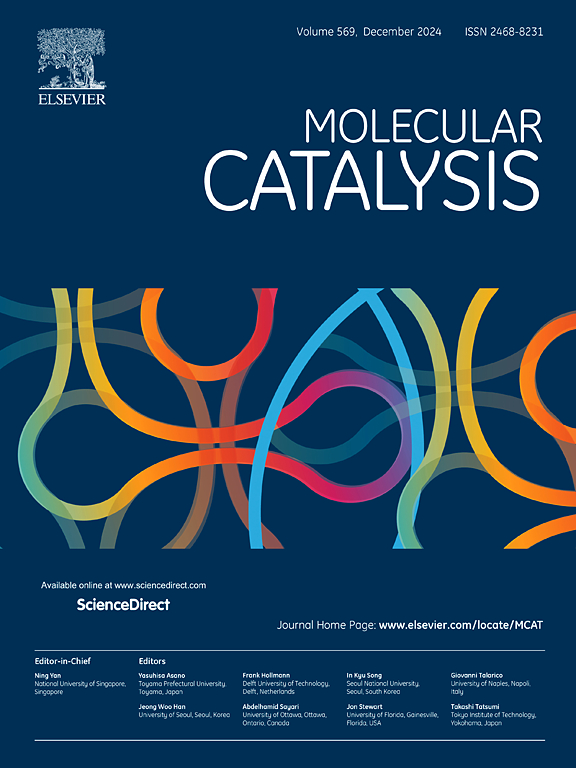Mechanistic interpretations and insights for the oxidative dehydrogenation of ethane with CO2 over alkali metal modified Zn/SSZ-13 catalyst
IF 3.9
2区 化学
Q2 CHEMISTRY, PHYSICAL
引用次数: 0
Abstract
Alkali metal promoted Zn/SSZ-13 catalysts were investigated for ethane dehydrogenation (EDH) and CO2-assisted oxidative ethane dehydrogenation (CO2-EDH). The Zn/Na/K/SSZ-13 demonstrated enhanced ethane dehydrogenation performance, achieving 0.381 mol C2H4 gZn-1 h-1 with a low deactivation rate constant of (kd) of 0.04 h-1 in the CO2-EDH process after 440 min time on stream, compared to the unmodified Zn/SSZ-13 catalyst. Comprehensive characterizations revealed that the isolated Zn2+ species serve as the active sites for dehydrogenation, while the addition of alkali metals compensate the acid sites of SSZ-13, effectively suppressing the side reactions such as cracking. Moreover, the introduction of CO2 mitigates Zn loss and enhances catalyst activity and stability by coupling with the reverse water gas shift reaction (RWGS), which also suppress the coke deposition. Investigation of vary CO2 content indicated that higher CO2 concentrations significantly suppress Zn loss and increase the proportion of the RWGS reaction, thereby improving CO2-EDH catalytic performance. This work elucidates the active phase of ethane dehydrogenation and highlights the role of alkali metals and CO2 in the CO2-EDH process over Zn/Na/K/SSZ-13, providing valuable insights for designing high-performance CO2-EDH catalysts.

碱金属改性Zn/SSZ-13催化剂上乙烷与CO2氧化脱氢反应机理的解释与认识
研究了碱金属促进Zn/SSZ-13催化剂对乙烷脱氢(EDH)和co2辅助氧化乙烷脱氢(CO2-EDH)的催化作用。与未改性的Zn/Na/K/SSZ-13催化剂相比,Zn/Na/K/SSZ-13催化剂的乙烷脱氢性能有所提高,在CO2-EDH过程中,经过440 min的反应时间,Zn/Na/K/SSZ-13催化剂的失活速率常数(kd)为0.04 h-1,达到0.381 mol C2H4 gZn-1 h-1。综合表征表明,分离的Zn2+作为脱氢的活性位点,而碱金属的加入补偿了SSZ-13的酸位,有效抑制了裂化等副反应。此外,CO2的引入通过与逆水气变换反应(RWGS)耦合,减轻了Zn的损失,提高了催化剂的活性和稳定性,也抑制了焦炭的沉积。不同CO2含量的研究表明,较高的CO2浓度可显著抑制Zn的损失,增加RWGS反应的比例,从而提高CO2- edh的催化性能。这项工作阐明了乙烷脱氢的活性相,并强调了碱金属和CO2在Zn/Na/K/SSZ-13上的CO2- edh过程中的作用,为设计高性能的CO2- edh催化剂提供了有价值的见解。
本文章由计算机程序翻译,如有差异,请以英文原文为准。
求助全文
约1分钟内获得全文
求助全文
来源期刊

Molecular Catalysis
Chemical Engineering-Process Chemistry and Technology
CiteScore
6.90
自引率
10.90%
发文量
700
审稿时长
40 days
期刊介绍:
Molecular Catalysis publishes full papers that are original, rigorous, and scholarly contributions examining the molecular and atomic aspects of catalytic activation and reaction mechanisms. The fields covered are:
Heterogeneous catalysis including immobilized molecular catalysts
Homogeneous catalysis including organocatalysis, organometallic catalysis and biocatalysis
Photo- and electrochemistry
Theoretical aspects of catalysis analyzed by computational methods
 求助内容:
求助内容: 应助结果提醒方式:
应助结果提醒方式:


